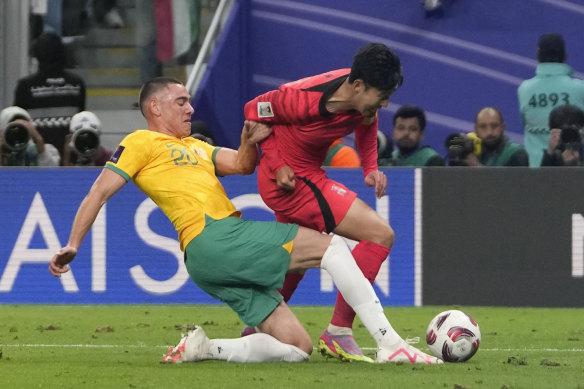
Football is a game of fine margins, on and off the field. Just ask Graham Arnold, who was stressing the importance of FIFA ranking points seven months ago.
The meticulous Arnold spotted from a mile out that they might really matter on the road to the 2026 World Cup — so much that, in the lead-up to January’s Asian Cup in Qatar, he was talking not only about winning matches for the benefit of their hopes at that tournament, but to ensure they would continue rising up FIFA’s world rankings.

Lewis Miller fouls Son Heung-min in the Asian Cup quarter-final.Credit: AP
It came off a bit weird of the time, but he was right. Say what you want about the man, but no detail is too small to get past him.
In retrospect, Lewis Miller’s clumsy challenge on Son Heung-min in the 96th minute of the Asian Cup quarter-final takes on even greater meaning. It was the moment Australia’s broader fortunes swung dramatically. The world No.23-ranked Socceroos could have leap-frogged the 22nd-placed South Korea — but they went from 1-0 up to a 2-1 defeat, and in the end, just 1.58 points separated them as Asia’s third and fourth best teams.
And so for Thursday night’s draw for the AFC’s third World Cup qualifying round, in which the 18 remaining nations were split into six pots of three, and then drawn into three groups of six, South Korea were in pot one, which meant they couldn’t face Japan or Iran, and Australia were in pot two, which meant they could.
In Riyadh, on the final match day of the AFC’s second qualifying round, Saudi Arabia were upset 2-1 by Jordan. As a result, they dropped down three places to No.56 in the world. Meanwhile, Iraq moved up three places to No.55. They are separated by 1.77 points. And so Iraq were in pot two with the Socceroos, and the Saudis slid down to pot three, which made them the most dangerous floater in the draw.
So of course this was going to happen.
For the third consecutive World Cup cycle, Australia, Saudi Arabia and Japan have landed in the same group. But it’s actually more ridiculous than that; Australia and Japan have landed in the same group at the same critical stage of World Cup qualification for every single campaign since Australia moved from Oceania to Asia: 2010, 2014, 2018, 2022, now 2026. They had China in 2022 as well.



























